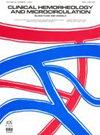PANoptosis and cardiovascular disease: The preventive role of exercise training.
IF 2.1
4区 医学
Q3 HEMATOLOGY
引用次数: 0
Abstract
Regulated cell death, including pyroptosis, apoptosis, and necroptosis, is vital for the body's defense system. Recent research suggests that these three types of cell death are interconnected, giving rise to a new concept called PANoptosis. PANoptosis has been linked to various diseases, making it crucial to comprehend its mechanism for effective treatments. PANoptosis is controlled by upstream receptors and molecular signals, which form polymeric complexes known as PANoptosomes. Cell death combines necroptosis, apoptosis, and pyroptosis and cannot be fully explained by any of these processes alone. Understanding pyroptosis, apoptosis, and necroptosis is essential for understanding PANoptosis. Physical exercise has been shown to suppress pyroptotic, apoptotic, and necroptotic signaling pathways by reducing inflammatory factors, proapoptotic factors, and necroptotic factors such as caspases and TNF-alpha. This ultimately leads to a decrease in cardiac structural remodeling. The beneficial effects of exercise on cardiovascular health may be attributed to its ability to inhibit these cell death pathways.细胞凋亡与心血管疾病:运动训练的预防作用
受调控的细胞死亡,包括热凋亡、细胞凋亡和坏死,对人体的防御系统至关重要。最近的研究表明,这三种细胞死亡是相互关联的,从而产生了一个新的概念--泛凋亡(PANoptosis)。细胞凋亡与多种疾病有关,因此了解其机制对有效治疗至关重要。泛凋亡受上游受体和分子信号的控制,这些受体和信号形成被称为泛凋亡小体(PANoptosomes)的聚合复合物。细胞死亡包括坏死、凋亡和热凋亡,无法单独用其中任何一个过程来完全解释。了解热凋亡、细胞凋亡和坏死对于了解 PANoptosis 至关重要。研究表明,体育锻炼可通过减少炎症因子、促凋亡因子和坏死因子(如 caspases 和 TNF-α)来抑制热解、凋亡和坏死信号通路。这最终会导致心脏结构重塑的减少。运动对心血管健康的有益影响可能归因于其抑制这些细胞死亡途径的能力。
本文章由计算机程序翻译,如有差异,请以英文原文为准。
求助全文
约1分钟内获得全文
求助全文
来源期刊
CiteScore
4.30
自引率
33.30%
发文量
170
期刊介绍:
Clinical Hemorheology and Microcirculation, a peer-reviewed international scientific journal, serves as an aid to understanding the flow properties of blood and the relationship to normal and abnormal physiology. The rapidly expanding science of hemorheology concerns blood, its components and the blood vessels with which blood interacts. It includes perihemorheology, i.e., the rheology of fluid and structures in the perivascular and interstitial spaces as well as the lymphatic system. The clinical aspects include pathogenesis, symptomatology and diagnostic methods, and the fields of prophylaxis and therapy in all branches of medicine and surgery, pharmacology and drug research.
The endeavour of the Editors-in-Chief and publishers of Clinical Hemorheology and Microcirculation is to bring together contributions from those working in various fields related to blood flow all over the world. The editors of Clinical Hemorheology and Microcirculation are from those countries in Europe, Asia, Australia and America where appreciable work in clinical hemorheology and microcirculation is being carried out. Each editor takes responsibility to decide on the acceptance of a manuscript. He is required to have the manuscript appraised by two referees and may be one of them himself. The executive editorial office, to which the manuscripts have been submitted, is responsible for rapid handling of the reviewing process.
Clinical Hemorheology and Microcirculation accepts original papers, brief communications, mini-reports and letters to the Editors-in-Chief. Review articles, providing general views and new insights into related subjects, are regularly invited by the Editors-in-Chief. Proceedings of international and national conferences on clinical hemorheology (in original form or as abstracts) complete the range of editorial features.

 求助内容:
求助内容: 应助结果提醒方式:
应助结果提醒方式:


